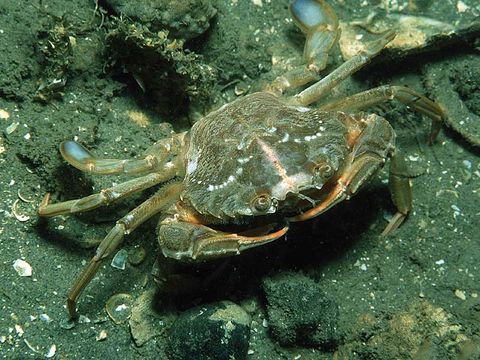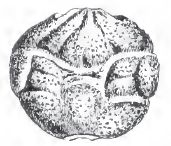Decapoda: Brachyura
Taxa on This Page
- Brachyura
- Cyclodorippoidea
- Dakoticancroidea X
- Dromiacea
- Prosopidae X
- Raninidae
- Raninoida
The crabs need no introduction, as they are such familiar inhabitants of the sea shore. They are also the most advanced, specialised, and succesful of the Crustacea; there are more species of crabs than all other malacostraca combined. First appearing in the Jurassic, crabs, or Brachyura to give them their scientific name, had become abundant by the early Tertiary, a success they still hold. Most Mesozoic crabs belonged to groups such as the Dromiacea and Raninoida. Although these groups still continue today, they have been mostly replaced by the more specialised crabs of the Eubrachyura group, which include by far the greatest number of extant species. MAK120523
Classification
The infraorder Brachyura contains 6,793 species in 93 families,[17] as many as the remainder of the Decapoda.[28] The evolution of crabs is characterised by an increasingly robust body, and a reduction in the abdomen. Although many other groups have undergone similar processes, carcinisation is most advanced in crabs. The telson is no longer functional in crabs, and the uropods are absent, having probably evolved into small devices for holding the reduced abdomen tight against the sternum.
In most decapods, the gonopores (sexual openings) are found on the legs. However, since crabs use the first two pairs of pleopods (abdominal appendages) for sperm transfer, this arrangement has changed. As the male abdomen evolved into a narrower shape, the gonopores have moved towards the midline, away from the legs, and onto the sternum.[29] A similar change occurred, independently, with the female gonopores. The movement of the female gonopore to the sternum defines the clade Eubrachyura, and the later change in the position of the male gonopore defines the Thoracotremata. It is still a subject of debate whether those crabs where the female, but not male, gonopores are situated on the sternum, form a monophyletic group.[28] - Wikipedia
[17] Peter K. L. Ng, Danièle Guinot & Peter J. F. Davie (2008). "Systema Brachyurorum: Part I. An annotated checklist of extant Brachyuran crabs of the world" (PDF). Raffles Bulletin of Zoology 17: 1–286.
[28] Joel W. Martin & George E. Davis (2001) (PDF). An Updated Classification of the Recent Crustacea. Natural History Museum of Los Angeles County. pp. 132.
[29] M. de Saint Laurent (1980). "Sur la classification et la phylogénie des Crustacés Décapodes Brachyoures. II. Heterotremata et Thoracotremata Guinot, 1977". Comptes rendus de l'Académie des sciences t. 290: 1317–1320.
Phylogeny
The following provisional phylogeny is from Christopher Taylor - Variety of LIfe Brachyura and Heterotremata
Eocarcinus praecursor Withers 1932 [Eocarcinidae] GT01 (basal anumara or basal meiura) Brachyura [Brachyuri] (Podotremata GT01 paraphyletic or polyphyletic -
De Grave et al 2009)
├─
Prosopidae
└─┬─Homolodromioidea MD01
└─┬─Dromiacea GT01
│ ├─Dromioidea MD01
│ │ ├─Dynomenidae MD01
│ │ │ ├─Acanthodromia erinacea Milne Edwards 1880 GT01
│ │ │ └─Metadynomene crosnieri McLay 1999 GT01
│ │ └─Dromiidae MD01
│ │ ├─Stimdromia GT01
│ │ ├─Dromidia spongiosa (Stimpson 1858) GT01
│ │ ├─Dromia W01
│ │ ├─Hypoconcha W01
│ │ ├─Petalomera GT01
│ │ ├─Dromilites GT01
│ │ └─Dromidiopsis australiensis (Haswell 1882) TSH09
│ └─Homoloidea MD01
└─┬─
Raninoida GT01 [Archaeobrachyura, Gymnopleura]
│ i. s.: Etyidae GT01
│ ├─
Dakoticancridae [Dakoticancroidea] GT01
│ ├─
Cyclodorippoidea [Tymoloidea] MD01
│ │ ├─Cymonomidae MD01
│ │ └─Cyclodorippidae MD01
│ └─Raninoidea MD01
│ ├─Symethis [Symethidae, Symethinae] MD01
│ └─
Raninidae CF06
│ ├─Ranina Lamarck 1801 B02 R. ranina (Linnaeus 1758)
│ ├─Notopus de Haan 1841 B02
│ └─Raninella Milne Edwards 1862 CF06
└─
Eubrachyura [Brachyrhyncha] GT01
├─Heterotremata GT01
│ │ i. s.: Secretanella Guinot & Tavares 2001 GT01 S. arcuata (Secretan 1964) [=Xanthosia arcuata] GT01
│ ├─Hapalocarcinus TSH09 [Cryptochiridae MD01, Cryptochiroidea, Hapalocarcinidae]
│ ├─Hymenosomatidae [Hymenosomatoidea] MD01
│ ├─Retropluma B68 [Retroplumidae, Retroplumoidea MD01]
│ ├─Bythograeidae [Bythograeoidea] MD01
│ ├─Belliidae [Bellioidea] MD01
│ ├─Dorippoidea SL03
│ │ ├─Dorippidae SL03
│ │ └─Orithyiidae MD01
│ ├─Leucosioidea MD01
│ │ ├─Leucosiidae MD01
│ │ └─Matutidae MD01
│ ├─Parthenopoidea MD01
│ │ ├─Parthenopidae GS79
│ │ ├─Aethra TSH09 [Aethridae MD01]
│ │ └─Daira TSH09 [Dairidae MD01]
│ ├─Portunoidea CA04
│ │ ├─Portunidae CA04
│ │ ├─Trichodactylidae MD01
│ │ └─Geryon H15 [Geryonidae MD01]
│ ├─Calappoidea SL03
│ │ ├─Hepatus BF07 [Hepatidae MD01]
│ │ └─Necrocarcinidae [Necrocarcininae] SL03
│ │ ├─Cenomanocarcinus Van Straelen 1936 CF06
│ │ ├─Orithopsis Carter 1872 SL03
│ │ └─Necrocarcinus Bell 1863 CF06
│ ├─Xanthoidea CA04
│ │ │ i. s.: Planopilumnus Balss 1933 NT85 P. spongiosus (Nobili 1905) [=Pilumnus spongiosus] NT85
│ │ │ Homalaspis MD01
│ │ ├─Xanthidae MD01
│ │ ├─Menippidae NT85
│ │ ├─Pilumnidae CA04
│ │ ├─Carpilius TSH09 [Carpiliidae MD01]
│ │ ├─Hexapodidae [Hexapodinae] MD01
│ │ ├─Platyxanthidae MD01
│ │ ├─Pseudorhombilidae MD01
│ │ ├─Trapeziidae MD01
│ │ ├─Goneplacidae MD01
│ │ ├─Eriphia Latreille 1817 B55 [Eriphiidae TSH09]
│ │ ├─Domeciidae TSH09
│ │ └─Tetralidae TSH09
│ ├─Cancroidea CA04
│ │ ├─Cancridae MD01
│ │ ├─Corystes B02 [Corystidae MD01]
│ │ ├─Cheiragonidae MD01
│ │ ├─Thia B02 [Thiidae MD01]
│ │ └─Atelecyclidae CA04
│ ├─Gecarcinucidae [Gecarcinucoidea, Potamonidae] MD01
│ │ │ i. s.: Thelphusula Bott 1969 H86
│ │ │ Adeleana Bott 1969 H86
│ │ ├─Barytelphusa Alcock 1909 DC06, BS05 [incl. Maydelliathelphusa Bott 1969 BS05]
│ │ └─┬─Sartoriana Bott 1969 DC06, BS05
│ │ └─┬─┬─Gecarcinucus jaquemonti DC06
│ │ │ └─┬─Gubernatoriana gubernatorus DC06
│ │ │ └─Parathelphusidae DC06
│ │ └─┬─Phricothelphusa limula DC06
│ │ └─┬─Pseudothelphusidae DC06
│ │ └─Potamoidea DC06
│ └─Majoidea MD01
│ ├─Pyromaia HJ08 [Inachoididae MD01]
│ ├─Tychidae MD01
│ ├─Inachidae TSH09
│ ├─Epialtidae TF08
│ └─Majidae MD01
└─
Thoracotremata MD01
├─Pinnotheridae MD01
├─Grapsoidea MD01
└─Ocypodoidea MD01
├─Camptandriidae [Camptandriinae] MD01
├─Palicidae MD01
├─Mictyris T03 [Mictyridae MD01]
├─Macropthalmidae TSH09 [Macrophthalminae MD01]
│ ├─Australoplax B68
│ ├─Cleistostoma B68
│ └─Macrophthalmus HS01
└─Ocypodidae MD01
├─Dotillinae MD01
├─Heloecius B68 [Heloeciinae MD01]
├─Scopimerinae B68
└─Ocypodinae
References
[B68] Barnes, R. S. K. 1968. On the evolution of elongate ocular peduncles by the Brachyura. Systematic Zoology 17 (2): 182-187.
[B02] Boyko, C. B. 2002. A worldwide revision of the recent and fossil sand crabs of the Albuneidae Stimpson and Blepharipodidae, new family (Crustacea: Decapoda: Anomura: Hippoidea). Bulletin of the American Museum of Natural History 272: 1-396.
[B55] Bott, R. 1955. Dekapoden (Crustacea) aus El Salvador. 2. Litorale Dekapoden, außer Uca. Senckenbergiana Biologica 36: 45-70.
[BBB-S95] Boubezari, K., G. Bitar & D. Bellan-Santini. 1995. Structure et organisation de trois moulières (Mytilus galloprovincialis et Perna perna) de la région d'Alger. Mésogée 54: 63-72.
[B02] Boyko, C. B. 2002. A worldwide revision of the recent and fossil sand crabs of the Albuneidae Stimpson and Blepharipodidae, new family (Crustacea: Decapoda: Anomura: Hippoidea). Bulletin of the American Museum of Natural History 272: 1-396.
[BF07] Braga, A. A., A. Fransozo, G. Bertini & P. B. Fumis. 2007. Bathymetric distribution and recruitment of the spider crab Libinia spinosa H. Milne Edwards 1834 in the Ubatuba and Caraguatatuba regions, northern coast of São Paulo, Brazil (Crustacea, Brachyura, Majoidea, Pisidae). Senckenbergiana Biologica 87 (1): 7-16.
[BS05] Brandis, D., & S. Sharma. 2005. Taxonomic revision of the freshwater crab fauna of Nepal with description of a new species (Crustacea, Decapoda, Brachyura, Potamoidea and Gecarcinucoidea). Senckenbergiana Biologica 85: 1-30.
[CA04] Casadío, S., A. de Angeli, R. M. Feldmann, A. Garassino, J. L. Hetler, A. Parras & C. E. Schweitzer. 2004. New decapod crustaceans (Thalassinidea, Galatheoidea, Brachyura) from the Middle Oligocene of Patagonia, Argentina. Annals of Carnegie Museum 73 (2): 25-47.
[CF06] Crawford, R. S., R. F. Feldmann, D. A. Waugh, B. M. Kelley & J. G. Allen. 2006. Decapod crustaceans from the Maastrichtian Fox Hills formation. Bulletin of the Peabody Museum of Natural History 47 (1-2): 3-28.
[CC05] Cristo, M. & M. Castro. 2005. Field estimation of daily ration of Norway lobster (Nephrops norvegicus) in the south of Portugal. New Zealand Journal of Marine and Freshwater Research 39 (3): 485-491.
[DC06] Daniels, S. R., N. Cumberlidge, M. Pérez-Losada, S. A. E. Marijnissen & K. A. Crandall. 2006. Evolution of Afrotropical freshwater crab lineages obscured by morphological convergence. Molecular Phylogenetics and Evolution 40 (1): 227-235.
[DAS03] Dixon, C. J., S. T. Ahyong & F. R. Schram. 2003. A new hypothesis of decapod phylogeny. Crustaceana 76: 935-975.
[F71] Fletcher, H. O. 1971. Catalogue of type specimens of fossils in the Australian Museum, Sydney. Australian Museum Memoir 13: 1-167.
[GS79] Gore, R. H., & L. E. Scotto. 1979. Crabs of the family Parthenopidae (Crustacea Brachyura: Oxyrhyncha) with notes on specimens from the Indian River region of Florida. Memoirs of the Hourglass Cruises 3 (6): 1-98.
[G75] Grant, E. M. 1975. Guide to Fishes. The Co-ordinator-General's Department: Brisbane (Australia).
[GT01] Guinot, D., & M. Tavares. 2001. Une nouvelle famille de crabes du Crétacé, et la notion de Podotremata Guinot, 1977 (Crustacea, Decapoda, Brachyura). Zoosystema 23 (3): 507-546.
[H15] Harmer, S. F. 1915. The Polyzoa of the Siboga Expedition – Part I. Entoprocta, Ctenostomata and Cyclostomata. E. J. Brill: Leyden.
[HS01] Hayward, B. W., A. B. Stephenson, M. S. Morley, W. M. Blom, H. R. Grenfell, F. J. Brook, J. L. Riley, F. Thompson & J. J. Hayward. 2001. Marine biota of Parengarenga Harbour, Northland, New Zealand. Records of the Auckland Museum 37: 45-80.
[HN-F08] Hirose, G. L., & M. L. Negreiros-Franzoso. 2008. Growth and juvenile development of Uca maracoani Latreille 1802-1803 in laboratory conditions (Crustacea, Decapoda, Brachyura, Ocypodidae). Senckenbergiana Biologica 88 (2): 161-168.
[H86] Holthuis, L. B. 1986. Decapoda. In Stygofauna Mundi: A Faunistic, Distributional, and Ecological Synthesis of the World Fauna inhabiting Subterranean Waters (including the Marine Interstitial) (L. Botosaneanu, ed.) pp. 589-615. E. J. Brill / Dr. W. Backhuys: Leiden.
[HJ08] Huisman, J. M., D. S. Jones, F. E. Wells & T. Burton. 2008. Introduced marine biota in Western Australian waters. Records of the Western Australian Museum 25 (1): 1-44.
[MD01] Martin, J. W., & G. E. Davis. 2001. An updated classification of the Recent Crustacea. Natural History Museum Los Angeles County, Science Series 39: 1-124.
[M62] Monniot, F. 1962. Recherches sur les graviers a Amphioxus de la région de Banyuls-sur-Mer. Vie et Milieu 13: 231-322.
[NT85] Ng, P. K. L., & L. W. H. Tan. 1985. Globopilumnus multituberosus Garth & Kim, 1983 – a new record for Australia (Decapoda: Crustacea: Menippidae). Records of the Australian Museum 36: 127-129.
[OT04] Olabarria, C., & M. H. Thurston. 2004. Patterns of morphological variation of the deep-sea gastropod Troschelia berniciensis (King, 1846) (Buccinidae) from the northeastern Atlantic Ocean. Journal of Molluscan Studies 70: 59-66.
[P71] Por, F. D. 1971. One hundred years of Suez Canal—a century of Lessepsian migration: retrospect and viewpoints. Systematic Zoology 20 (2): 138-159.
[PTB03] Portell, R. W., R. L. Turner & J. L. Beerensson. 2003. Occurrence of the Atlantic ghost crab Ocypode quadrata from the Upper Pleistocene to Holocene Anastasia Formation of Florida. Journal of Crustacean Biology 23 (3): 712-722.
[PB06] Poupin, J., & J. M. Bouchard. 2006. The eastern Pacific species of the genus Calcinus Dana, 1851, with description of a new species from Clipperton Island (Decapoda, Anomura, Diogenidae). Zoosystema 28 (2): 465-486.
[ST76] Sakai, K., & M. Türkay. 1976. Bemerkungen zu einigen Ocypode-Arten (Crustacea: Decapoda). Senckenbergiana Biologica 57 (1-3): 81-96.
[SL03] Schweitzer, C. E., K. J. Lacovara, J. B. Smith, M. C. Lamanna, M. A. Lyon & Y. Attia. 2003. Mangrove-dwelling crabs (Decapoda: Brachyura: Necrocarcinidae) associated with dinosaurs from the Upper Cretaceous (Cenomanian) of Egypt. Journal of Paleontology 77 (5): 888-894.
[T03] Takeda, S. 2003. Mass wandering in the reproductive season by the fiddler crab Uca perplexa (Decapoda: Ocypodidae). Journal of Crustacean Biology 23 (3): 723-728.
[TF08] Teixeira, G. M., V. Fransozo, A. L. Castilho, R. C. da Costa & F. A. d. M. Freire. 2008. Size distribution and sex ration in the spider crab Epialtus brasiliensis (Dana 1852) associated with seaweed on a rocky shore in southeastern Brazil (Crustacea, Decapoda, Brachyura, Majoidea, Epialtidae). Senckenbergiana Biologica 88 (2): 169-175.
[TSH09] Titelius, M. A., A. Sampey & C. G. Hass. 2009. Crustaceans of Mermaid (Rowley Shoals), Scott and Seringapatam Reefs, north Western Australia. Records of the Western Australian Museum Supplement 77: 145-176.
[W01] Williamson, D. I. 2001. Larval transfer and the origins of larvae. Zoological Journal of the Linnean Society 131: 111-122.
Descriptions

Brachyura Latreille, 1802
Phylogeny: Meiura : Anomura + * : Dromiacea + Raninoida + Eubrachyura)))
Characters:. Synapomorphies (from Dixon et al. 2003): Orbito-antennularis fossa present, formed by carapace and one or more antennae; third maxillipedes operculiform; uropods absent; telson without any specialization for escape or digging. Posterior edge of carapace straight, second pleomere not expanded. First and second male pleopods arranged so that the second pleopod passes through the first, the two collectively forming a single gonopod. - CKT.
Comments The true crabs, a group of decapods in which the reduced abdomen is held to the underside of the sternum. - CKT.
Image: Spanner crab Ranina ranina (Brachyura: Raninoida: Raninoidea:Raninidae), a representative of group that was very succesful during the Cretaceous and Tertiary. Photographed by Massimo Boyer.
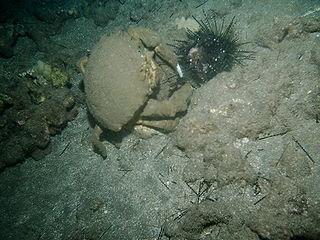
Dromiacea
Phylogeny: Brachyura : Dromiacea + Raninoida + Eubrachyura
Comments: The Dromiacea are known from 240 extant and nearly 300 extinct species. If the number of fossil species are only a fraction of the total that ever lived, that means that the extent species are merely the remnants of a much more diverse, Mesozoic and early Tertiary group MAK120523. They differ from the more specialised Brachyura in retaining many primitive characters. Thus, the last somite of the abdomen often retains vestiges of uropods, the first abdominal somite of the female has a pair of appendages, the fossettes for the reception of the antennules are less clearly defined, and the gills are more numerous. - Zittel & Eastman 1913. The larvae of Dromiacea also resemble those of the Anomura more closely than those of other crabs, reflecting their basal position in the crab phylogeny. - from Wikipedia
|
Mesozoic Dromiacea, fossilised carapaces, from left to right: Prosopon marginatum, v. Meyer. Late Jurassic, Oerlinger Valley, near Ulm, Baden-Württemberg, Germany; P. personatum. Late Jurassic; Weissingen, Wurtemberg. Rostrum enlarged. P. aculeutum v. Meyer .Same locality as P. marginatum; P. pustulatum Quenstedt, ditto; Dromiopsis rugosa (Schlotheim). Latest Cretaceous, Faxoe, Denmark. - Zittel & Eastman 1913, figs 1484-5. |
Among the Recent Dromiacea, again, the family Homolodromiidae is the most primitive, its members, which inhabit the deep sea, presenting many features which link them with the Lobsters of the tribe Nephropsidea. The earliest fossil Brachyura, forming the extinct family Prosoponidae, are allied, by the form of the carapace and its grooves, to the existing Homolodromiidae. In the majority of cases the carapace alone is preserved, but portions of the abdomen and limbs are known in Protocarcinus (Palaemachus) Woodward, from the Forest Marble (Bathonian) of England. The genns Prosopon von Meyer is even earlier, appearing in the Bajocian and persisting to the Neocomian. Later forms approach more specialised Recent types, such as Homolopsis Bell from the Gault, leading towards the Homolidae; and Dromiopsis Reuss, leading towards the Dromiidae. The Tertiary Dromilites Milne Edwards, is scarcely different from the Recent Dromia.- Zittel & Eastman 1913 (public domain, slightly edited,) - needs updating
Image: above right, The sponge crab Dromidiopsis dormia (Dromioidea: Dromiidae) eating a sea urchin off the coast of Maui, Hawaii. Photo by Sasquatch, Creative Commons Attribution Share Alike, GNU Free Documentation License, via Wikipedia
Raninoida
Phylogeny: Brachyura : Dromiacea + Eubrachyura + * : Cyclodorippoidea + Dakoticancroidea + Raninidae
Characters: Complete loss of the uropods, without even a modified remnant (Guinot & Tavares 2001) - CKT
Comments: Also called Archaeobrachyura. Unlike other crabs, the abdomen is not folded under the thorax.
Dakoticancridae
Phylogeny: Raninoida : Cyclodorippoidea + Raninidae + *
Cyclodorippoidea
Phylogeny: Raninoida : Dakoticancroidea + Raninidae + *
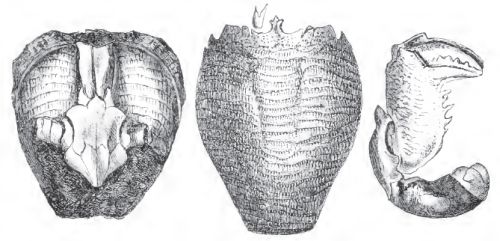
Tertiary fossils of the family Raninidae. Ranina (Lophoranina) marestiana König, 1825, Eocene; Kressenberg, Bavaria. Ventral and dorsal views (this species is also known from Monte Baldo, Italy). Chela (claw) of R.bouilleana A. Milne Edwards, 1872; Early Oligicene of Biarritz, Prance. - Zittel & Eastman 1913, figs 1488. |
Raninidae
Phylogeny: Raninoida : Cyclodorippoidea + Dakoticancroidea + *
Characters: Complete loss of the uropods, without even a modified remnant (Guinot & Tavares 2001) - CKT and by the unusual form of the chelae and by the elongate carapace,which is broader in front than behind Zittel & Eastman 1913
Comments: The Raninidae are a strange group of crabs that resemble frogs, hence the name (Rana - frog). These animals closely resemble the unrelated mole crabs (Anomura: Hippoidea) , due to convergent evolution. In both groups, the claws are modified into tools for digging, and the body is a rounded shape that is easy to bury in sand. Only 46 extant species, but nearly 200 fossil species are known Wikipedia) showing that modern species are the remnants of a previously much more abundant and diverse group. They appear during the Middle Cretaceous (Albian and Cenomanian) , and are common during the early Tertiary. Raniella and Raninoides Milne Edwards, are Cretaceous genera. Of the few Recent genera, Ranina Lamarck is also known from the Eocene.- Wikipedia, Zittel & Eastman 1913 (public domain)
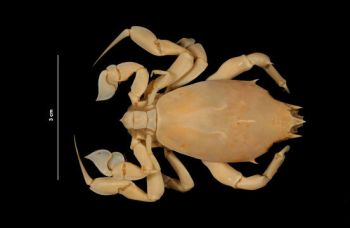
Image: Lyreidus bairdii Smith dorsal view. Scale: 3 cm. This elongate species has a particularily frog-like appearance, other raninids with wider carapaces are more typically crab-like in appaerance. All share the nonfolded abdomen (left in this image). Image © Smithsonian Institution, National Museum of Natural History, Department of Invertebrate Zoology, via Encyclopedia of Life, Creative Commons Attribution Non-Commercial Share-Alike
